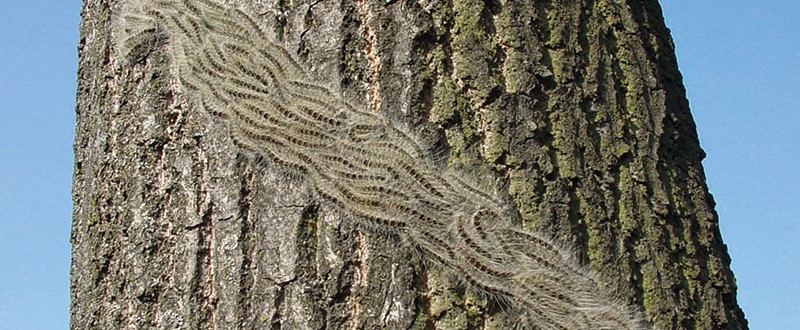Landscapers, nurseries, landowners and woodland managers are being urged to take action after the Plant Health Service intercepted a number of cases of Oak Processionary Moth caterpillars (OPM) on trees imported from the Netherlands.
Anyone who has planted larger oaks (defined below) imported from the continent should urgently check their trees for OPM and report any findings to TreeAlert. It is vital that these trees are checked now to minimise the spread of this damaging tree pest and protect the health of our oak trees.
OPM is an established pest in parts of London and surrounding areas, but the rest of the country is designated as a Protected Zone. Swift action is being taken by the Plant Health Service to eradicate recent findings of OPM in Hampshire, Warwickshire and Gloucestershire, including surveillance, tracing work and destruction of both the caterpillars and infested trees. The Plant Health Service have also announced an urgent review of import controls on oaks.
OPM caterpillars feed on oak leaves and can increase trees’ vulnerability to attack by other pests and diseases, making them less able to withstand weather conditions such as drought and floods. The cases highlight the need for continued vigilance from industry and government to protect the UK’s trees.
Dr Anna Brown, Head of Tree Health & Contingency Planning, Forestry Commission, said: “Those of us involved in importing or trading plants must maintain our vigilance against exotic pests and diseases such as OPM. There is a lot we can do such as buying British, only buying stock from reputable, responsible suppliers and inspecting imported plants.
“Inspect, inspect and inspect again – we can’t check imported plants too often for signs of trouble. Don’t presume that because your supplier found no evidence of a pest or disease that you won’t either. You might spot something that they have missed.”
The Forestry Commission, councils and land managers tackle the pest with an annual control programme of tree treatment. Increased measures to protect the country from the spread of OPM were introduced in 2018. Restrictions on the import of most species of oak into England have also been introduced as part of these regulations to protect native trees.
Professor Nicola Spence, Defra Chief Plant Health Officer, said: “Since 2012 we have invested more than £37 million in tree health research, including a dedicated programme of research and development on oak.
“We will continue to work with local authorities and land managers to tackle OPM with a control programme of treatment and surveillance. In 2018, we introduced tighter restrictions on the importation of oak trees to England but are now looking at options to strengthen these even further.
“The Plant Health Service has received reports of an exceptional expansion of the OPM population in parts of Europe, due the hot weather experienced last year.”
If you suspect OPM, you should not attempt to destroy or move infected material yourself as the nests and caterpillars can pose some risks to human health. For more on how to identify OPM, visit https://www.forestresearch.gov.uk/opm.



